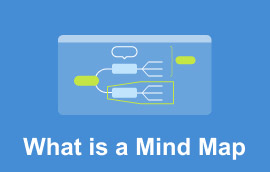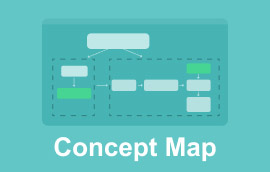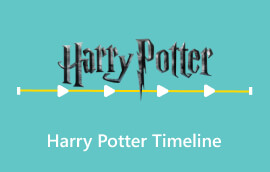Easiest Method to Help Make a World History Timeline
World history is a vast and complex epic that covers the long years from the origin of human beings. Studying history can increase understanding of the past and draw wisdom and lessons to guide the present and inform the future.
Timelines can help tease out events of world history in chronological order. Follow us to learn how to create world history timelines.

Part 1. How to Make a World History Timeline
To have a comprehensive understanding of world history, we need to make a world history timeline to help us better know history. How to make a history timeline? The best tool to help you is MindOnMap.
MindOnMap is a powerful charting tool that focuses on providing users with intuitive and easy mind maps, which is a good choice for making world history timelines. It can be used online or downloaded on Windows and Mac. We can use its free version to make our timelines. At the same time, we can also export the generated world history timelines into JPG, and PNG formats for free. Furthermore, the platform integrates a large number of templates and themes, and we can choose the proper template or customize the style and layout of the chart to create timelines.
Here are the steps for making a timeline of world history.
Go to the official website of MindOnMap. Click Create Online to jump to the operation webpage and create a personal account.
Note
You can also choose the Free Download button to install it on your computers.

Click New on the left menu bar and select the Right Map model to establish a new timeline to explain world history.
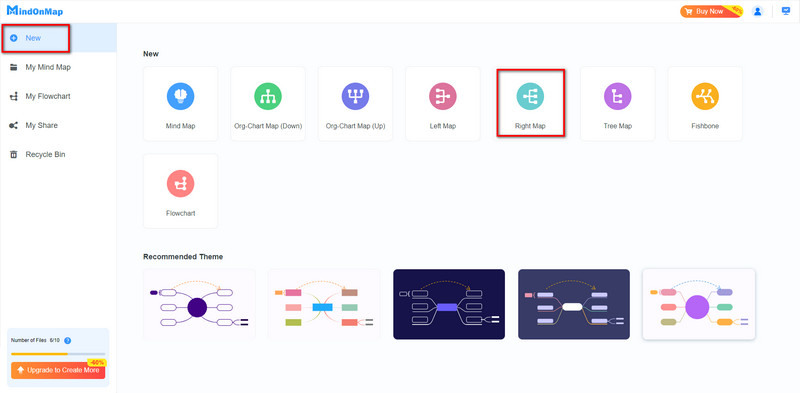
Double-click the textbox to enter the title of the world history timeline.

Select the textbox to which we want to add a subtopic and then click Subtopic in the toolbar.
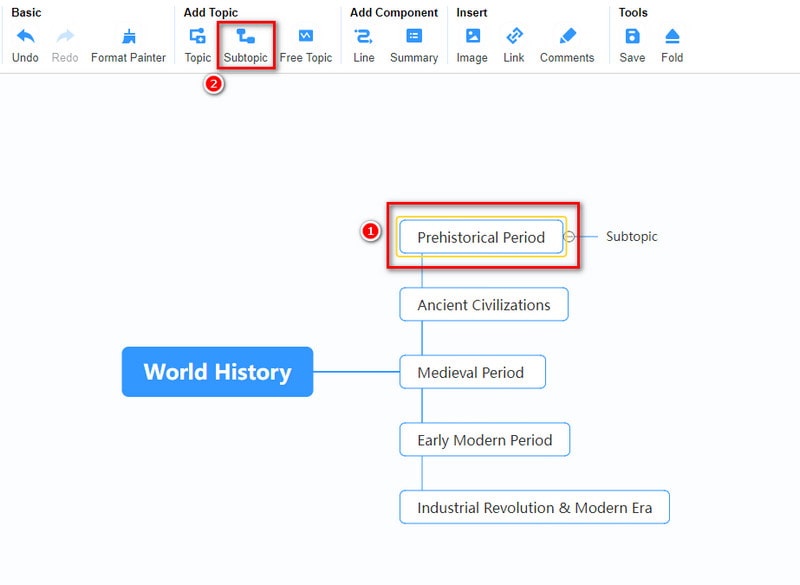
Repeat step 4 to add more subtopics and enter more information about world history to complete the timeline's content.
To make the world history timeline more vivid, we can insert images in the timeline. Click the textbox we want to add an image first, then click Image in the menu bar and Insert Image in its drop-down option to add.
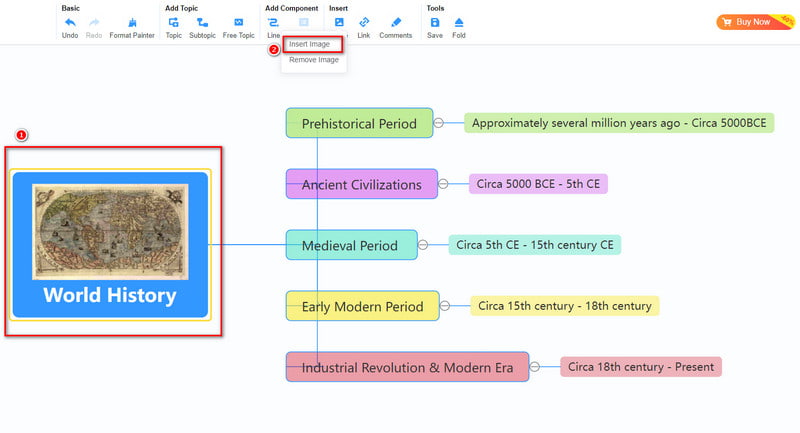
Go to the right toolbar to customize your editing. Click the Style setting to change the colors of the textbox to distinguish the different periods of world history.
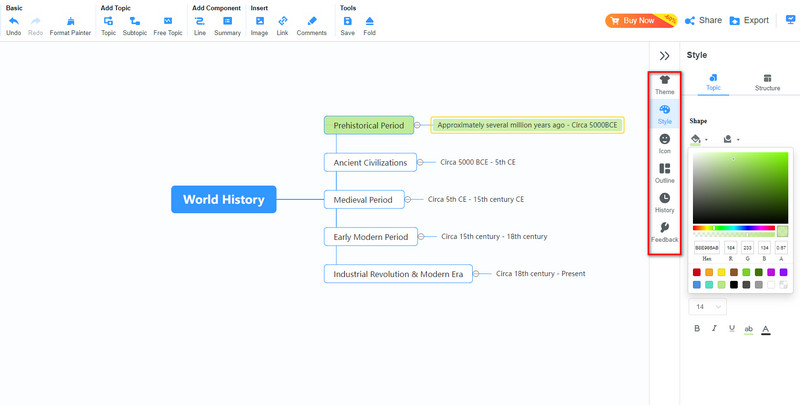
Rename the completed timeline in the top left corner. Click Share to duplicate the link of the world history timeline or Export to save the SD JPG or PNG image with watermarks for free.
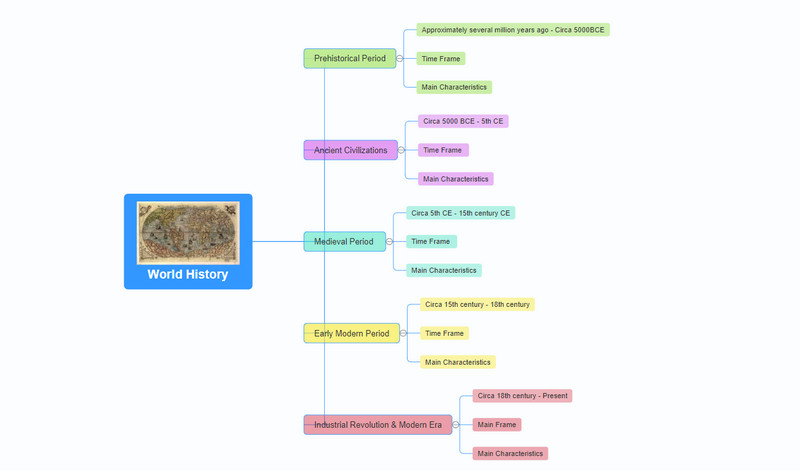
Note
You can also export more formats, such as SVG files, Word, etc., by upgrading.
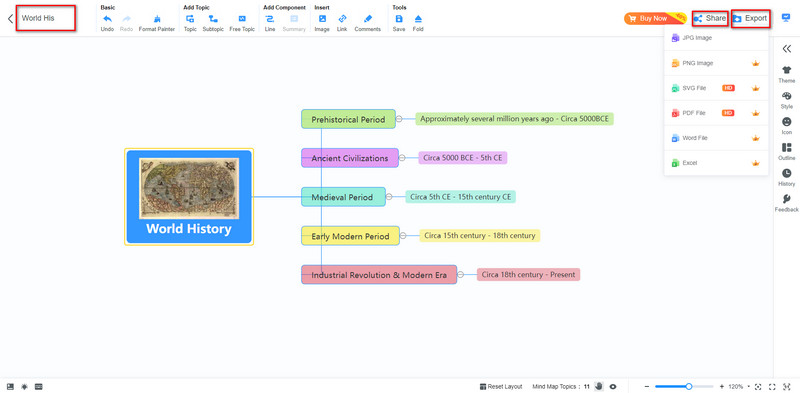
Part 2. World History Explanation
World history is a lengthy and intricate journey that can broadly be divided into the following 5 time periods, each marked by unique characteristics and significant events. Here's a brief introduction to world history and its corresponding time frames:
I. Prehistoric Period (Approximately Several Million Years Ago - Circa 5000 BCE)
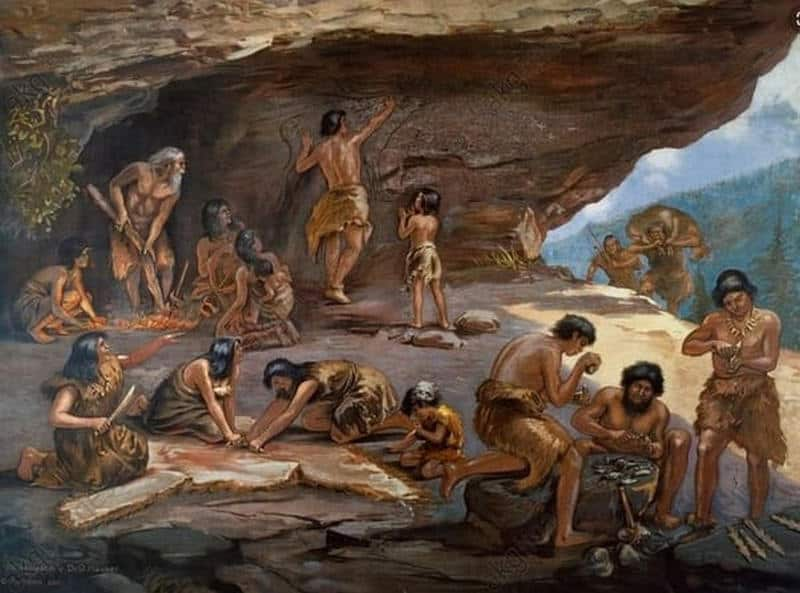
Time Frame: Beginning with human origins until the dawn of civilization.
Main Characteristics:
• Early human evolution: From Homo habilis, Homo erectus to Homo sapiens.
• Formation of primitive societies: Tribal and clan organization emerges.
• Subsistence strategies: Hunting and gathering, gradually evolving into agriculture and animal husbandry.
II. Ancient Civilizations (Circa 5000 BCE - 5th Century CE)
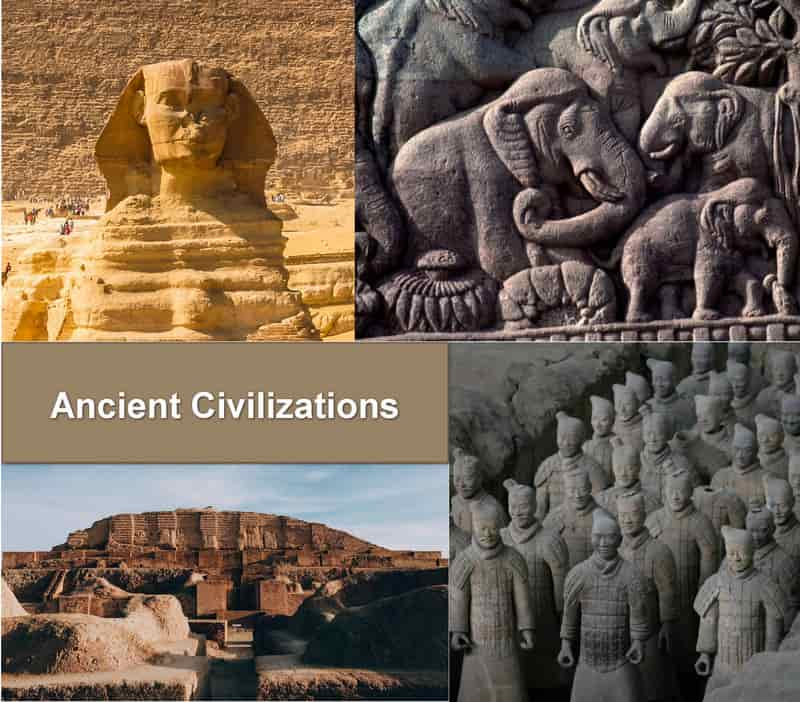
Time Frame: Encompassing the rise and fall of multiple ancient civilizations.
Key Civilizations:
• Ancient Egyptian Civilization (Circa 3100 BCE - 30 BCE): Hieroglyphics, pyramids, pharaonic rule.
• Mesopotamian Civilization (Sumer, Babylon, etc., Circa 3500 BCE - 539 BCE): Cuneiform script, Code of Hammurabi, Hanging Gardens of Babylon.
• Ancient Indian Civilization (Harappa, Mohenjo-daro, etc., Circa 2600 BCE - 1750 BCE): Urban planning, trade networks.
• Ancient Greek Civilization (Circa 800 BCE - 146 BCE): City-states, philosophy, theater, Olympic Games.
• Ancient Roman Civilization (Roman Republic - Roman Empire, Circa 509 BCE - 476 CE): Legal system, architectural art, the spread of Christianity.
III. Medieval Period (Circa 5th Century CE - 15th Century CE)
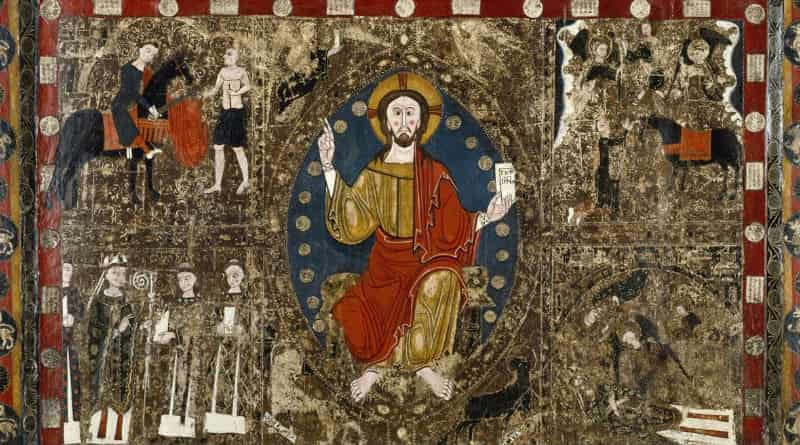
Time Frame: Medieval Period is the era of feudalism's formation and development in Europe.
Main Characteristics:
• Establishment of feudalism: Relationships between lords and vassals, the rise of the manorial economy.
• Profound influence of Christianity: The Church becomes a significant political force.
• Seeds of Renaissance: Renewed interest in classical culture.
IV. Early Modern Period (Circa 15th Century - 18th Century)
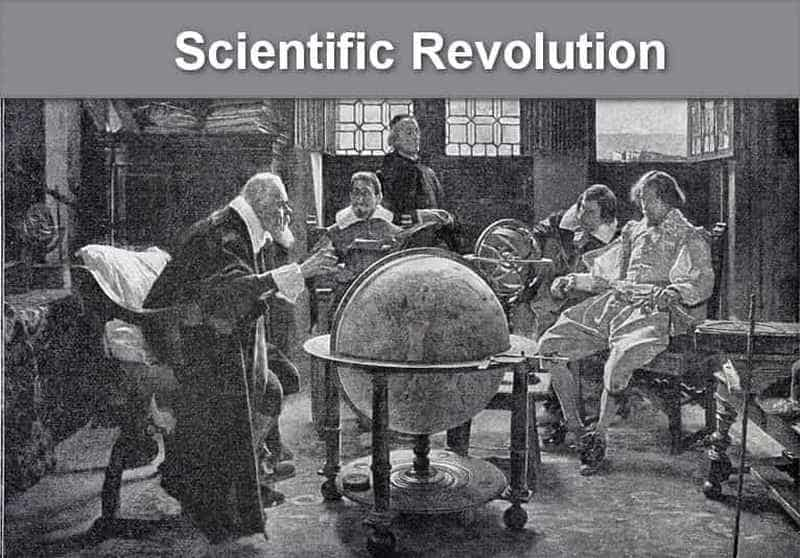
Time Frame: From the Renaissance to the eve of the Industrial Revolution.
Major Events:
• Renaissance (14th - 17th Centuries): Humanism flourishes, significant achievements in art, science, and philosophy.
• Reformation (16th Century): Led by Martin Luther, challenging the authority of the Catholic Church.
• Age of Discovery (15th - 16th Centuries): Explorers like Dias, Da Gama, and Columbus discover new worlds, connecting the globe.
• Scientific Revolution (17th Century): Newton and others formulate theories like the law of universal gravitation, shaping scientific methodology.
V. Industrial Revolution & Modern Era (Circa 18th Century - Present)
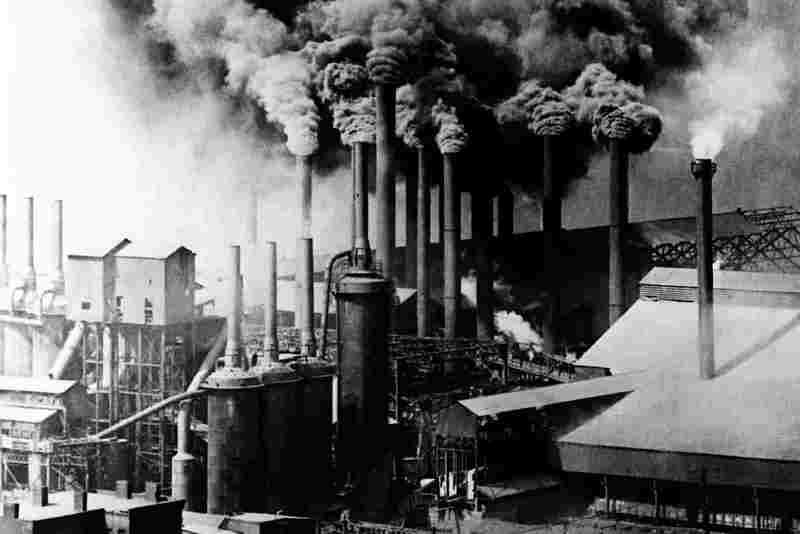
Time Frame: Commencing with the Industrial Revolution to the present day.
Main Characteristics:
• Industrial Revolution (1760s - Mid-19th Century): Widespread use of steam engines, machine production replaces hand labor, and productivity soars.
• Political Transformations: Bourgeois revolutions and reforms, such as the French Revolution, American Revolution, and British Parliamentary Reform.
• Technological Advancements: The Second Industrial Revolution (1870s - Early 20th Century) introduces electricity and internal combustion engines; the Third Industrial Revolution (1940s - Present) focuses on information technology, biotechnology, and more.
• Globalization: With advancements in transportation and communication, the world has become increasingly interconnected.
Note
Because of the complexity and diversity of historical processes, the above division and description may have certain subjectivity and limitations.
It should be noted that the division of time stages is not absolute, and historians with different cultural backgrounds may have different ways. In addition, the development of world history is a continuous process, and the various stages are not completely separated but have mutual interweaving and influence.
Part 3. FAQs
What are the major historical events of the world?
There are many major historical events, such as the American Revolution, the Industrial Revolution, the World War I, the Great Depression, the World War II, etc.
When did world history begin?
The written history began in Babylon, 3000 years before Christ. The historical narrative began in about 2000 years BC.
What is the most historic moment in history?
The use of fire, the invention of language, the development of tools and metallurgy, the Scientific Revolution, and the twice Industrial Revolution
Conclusion
Today, we introduce how to create a world history timeline with a powerful tool, MindOnMap. The timeline is a useful form to help us have a clearer understanding of the subject. To learn more about world history, MindOnMap will be the best choice for you to comb big events and clarify the point.
Have you ever learned how to make a timeline? If you have problems, please comment us and we will reply in time.








